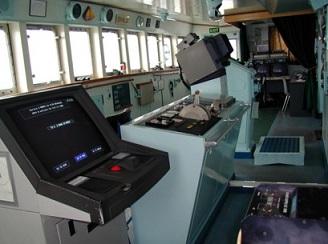Cargo ships navigational watch procedure - safety check items
Navigation at sea is referred to as the voyage practices, monitoring and controlling the ship's movement from point "A" to point "B." Special consideration needs to be made for the safety of the vessel concerning prevailing weather conditions. Considering various hazards that a ship may be exposed to, sea shortest distance between two places may not always be preferable.
Rough weather puts extra strain ships' main engine, and it incurs additional fuel consumption. Therefore, a prudent shipmaster must apply his best judgment while selecting an optimal route across the ocean. Navigation at sea thus a challenging task, as it requires both knowledge and skills. It is especially true in modern-day GPS navigation- but it was also true during earlier practice celestial only navigation.



Navigational watch at sea involves many complexities, and careful consideration will need to be made for a safe passage.
Summarized below are some basic check items that need to be complied with. Bridge watch officers should also keep in mind ship specific manoeuvering characteristics.
Navigational watch check items -
Have you confirmed and signed instructions in the Master's order book?
-
Have you checked the navigational warnings?
-
Have you confirmed charts to be used while being on watch?
-
Courses (confirm using a parallel ruler or triangular ruler)
-
Next course alteration point and its estimated time
-
Obstacles, shallows and navigable waters near the course line
-
Setting of parallel indexes (danger line)
-
Are the fire detecting systems in operation? Any zone isolation?
-
Have you personally confirmed the position of the vessel?
-
Are lights and shape signals indicated appropriately?
-
Vision adjusted to darkness (at night)?
-
Have you confirmed the condition around and on the vessel?
-
Have you confirmed operational radar & ARPA conditions (tune, gain control, CPA/TCPA setting, clutter setting, speed input)?
-
Have you confirmed correct display & position input of ECDIS / Chart Plotter (if fitted) incl. status of alarms if any?
-
Are nautical instruments / equipment and steering gear working normally?
-
Is VHF being used on the right channel and set to suitable volume / squelch?
-
Course (true course, gyro course and magnetic course)
-
Speed (speed over ground and log speed)
-
Deviation from the course line / XTE (Cross Track Error)
-
RPM of the Main engine
-
Movement of other ships around the vessel & other targets
-
Draft of the ship and predicted UKC
-
Weather and sea conditions
-
Engine Room status
-
Instructions from the Master & any permit to work issued
Related articles
Collecting Information and Data for Passage Planning
Ships navigational equipment and required check items
Rules of watchkeeping in port
Port watch check item- guide to safe cargo handling

Other info pages !
Ships Charterparties Related terms & guideline
Stevedores injury How to prevent injury onboard
Environmental issues How to prevent marine pollution
Cargo & Ballast Handling Safety Guideline
Reefer cargo handling Troubleshoot and countermeasures
DG cargo handling Procedures & Guidelines
Safety in engine room Standard procedures
Questions from user and feedback Read our knowledgebase
Home page

ShipsBusiness.com is merely an informational site about various aspects of ships operation,maintenance procedure,
prevention of pollution and many safety guideline. The procedures explained here are only indicative,
not exhaustive in nature and one must always be guided by practices of good seamanship.
User feedback is
important to update our database. For any comment or suggestions please Contact us
Site Use and Privacy - Read our privacy policy and site use information.
//Home //Terms and conditions of use
Copyright © 2015 www.shipsbusiness.com All rights reserved.



